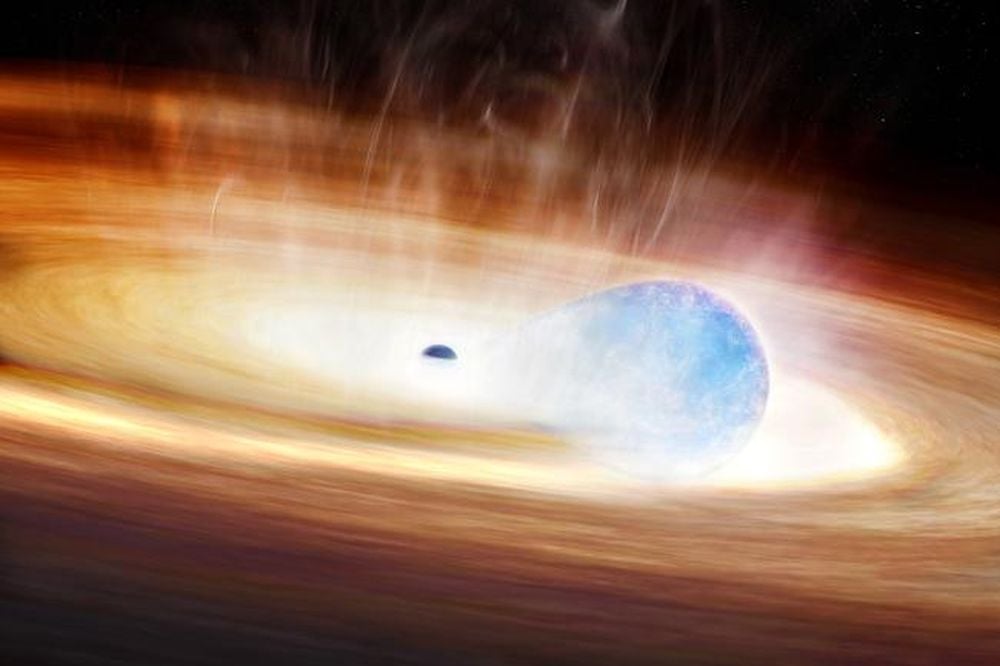Science
Distant Supernova Explosion Linked to Black Hole Encounter

A rare cosmic event has been observed as a supernova, named SN 2023zkd, appears to have detonated due to interactions with a black hole companion. Detected by the Zwicky Transient Facility (ZTF) in July 2023, this explosion, located approximately 730 million light-years from Earth, presents a unique opportunity for astrophysicists to study the dynamics of stellar death.
The ZTF employs an automated survey system that monitors the night sky for transient objects that exhibit changes in brightness. When SN 2023zkd was identified, astronomers quickly began follow-up observations, which are crucial for understanding phenomena that evolve over time. The findings are documented in a paper titled “Evidence for an Instability-induced Binary Merger in the Double-peaked, Helium-rich Type IIn Supernova 2023zkd,” published in The Astrophysical Journal. The study is led by Alexander Gagliano, a fellow at the NSF Institute for Artificial Intelligence and Fundamental Interactions.
Unraveling the Mystery of SN 2023zkd
The supernova exhibited persistent and luminous emissions for approximately four years before its explosion. Following its discovery, the brightness peaked twice, with intervals of around 240 days between these peaks. The researchers utilized both archival data and real-time observations from various telescopes to create a detailed light curve that revealed the unusual behavior of the supernova.
Gagliano and his colleagues noted that the gradual increase in brightness leading up to the explosion is atypical for a supernova. They evaluated several hypotheses, including the core collapse of a single massive star. The supernova showed characteristics associated with either a luminous blue variable or a carbon-rich Wolf-Rayet star, both of which are known to explode as supernovae. Ultimately, these explanations did not align well with the observed data.
Instead, the researchers concluded that SN 2023zkd is likely the result of a binary-driven merger supernova. The initial peak in brightness is thought to have been caused by the supernova’s blast wave interacting with ejected materials from the star, while the subsequent peak resulted from a slower collision with a dense cloud of material surrounding the star.
Significance of the Findings
The investigation suggests that the explosion involved a binary system of a 30 solar-mass star interacting with a 10 solar-mass black hole. This interaction indicates a period of unstable mass transfer leading up to the supernova event. Gagliano commented, “Our analysis shows that the blast was sparked by a catastrophic encounter with a black hole companion, and is the strongest evidence to date that such close interactions can actually detonate a star.”
Co-author V. Ashley Villar, an assistant professor of astronomy at Harvard, emphasized the significance of these observations, stating that they might represent a new class of hidden explosions, which artificial intelligence could help discover in the future.
The researchers advocate for continued multiwavelength monitoring of SN 2023zkd to further clarify the properties of the circumstellar matter and confirm the binary origin of the explosion. The upcoming Vera C. Rubin Observatory is expected to enhance observational capabilities, with projections to identify approximately 100,000 supernovae per year starting in 2025.
“This discovery shows how important it is to study how massive stars interact with companions as they approach the end of their lives,” Gagliano added. As technology advances, the integration of AI in astronomical observations is likely to lead to more significant discoveries, helping scientists connect the dots between stellar evolution and destruction.
-

 Technology5 months ago
Technology5 months agoDiscover the Top 10 Calorie Counting Apps of 2025
-

 Health3 months ago
Health3 months agoBella Hadid Shares Health Update After Treatment for Lyme Disease
-

 Health3 months ago
Health3 months agoErin Bates Shares Recovery Update Following Sepsis Complications
-

 Technology4 months ago
Technology4 months agoDiscover How to Reverse Image Search Using ChatGPT Effortlessly
-

 Technology1 month ago
Technology1 month agoDiscover 2025’s Top GPUs for Exceptional 4K Gaming Performance
-

 Technology3 months ago
Technology3 months agoElectric Moto Influencer Surronster Arrested in Tijuana
-

 Technology5 months ago
Technology5 months agoMeta Initiates $60B AI Data Center Expansion, Starting in Ohio
-

 Technology5 months ago
Technology5 months agoRecovering a Suspended TikTok Account: A Step-by-Step Guide
-

 Health4 months ago
Health4 months agoTested: Rab Firewall Mountain Jacket Survives Harsh Conditions
-

 Lifestyle5 months ago
Lifestyle5 months agoBelton Family Reunites After Daughter Survives Hill Country Floods
-

 Health3 months ago
Health3 months agoAnalysts Project Stronger Growth for Apple’s iPhone 17 Lineup
-

 Technology4 months ago
Technology4 months agoHarmonic Launches AI Chatbot App to Transform Mathematical Reasoning




















